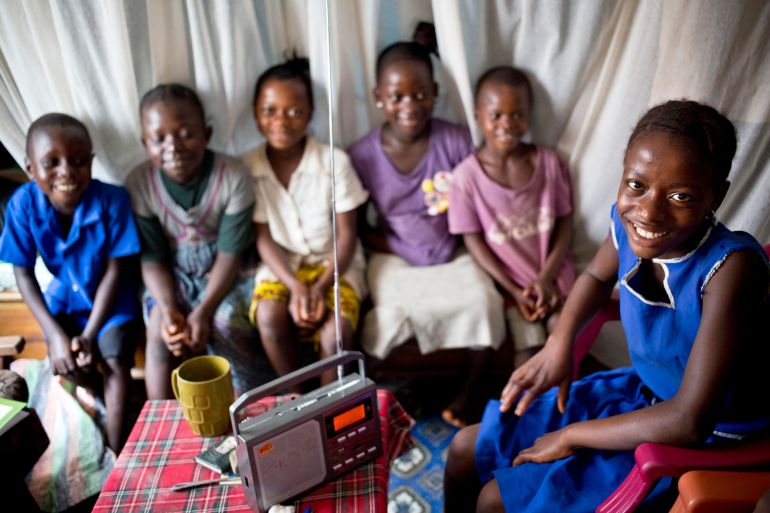The power of radio in Sierra Leone
In Sierra Leone, the Radio Teaching Programme is helping children access education during disease outbreaks and beyond.

I was only a few months into my new role as Sierra Leone’s education minister when the COVID-19 pandemic hit. At the peak of the crisis, up to 1.6 billion children across the world found themselves unable to attend school in person. Many countries were caught off guard and struggled to find ways for children to continue their education at home. In Sierra Leone, however, we were prepared for the school closures that arise from such pandemics. The interactive Radio Teaching Programme that we established during the 2014-16 Ebola crisis meant that we were ready to provide distance schooling to millions of students.
During the Ebola outbreak, students were out of school for the larger part of nine months. These were the years before Zoom calls and online learning platforms for schools. Besides, very few households had access to internet technology in Sierra Leone. It was decided that radio programming would be the most efficient method to deliver lessons as it was cost-effective, engaging, and could easily be adapted to local languages.
Keep reading
list of 4 itemsColumbia University’s Shafik rebuked over Gaza crackdown but avoids censure
Generation gap: What student protests say about US politics, Israel support
Are US campus protests against Israel’s war on Gaza going global?
Using funding from the Global Partnership for Education, 80,000 portable radio sets were distributed to learners in 2014. The best teachers were selected to present compelling lessons to 1.8 million learners. It worked well. While the radio teaching programme ended when the Ebola crisis was over, the ministry kept the Education Radio station alive.
When COVID-19 emerged as a new threat to in-person teaching, we knew we could rely on radio programmes to deliver lessons and prevent students from falling behind on their education. We retrained teachers and adjusted the curriculum, so in March 2020, when Sierra Leone’s first COVID-19 case was recorded and the schools were closed down, we were ready to start distance learning. Children in Sierra Leone tuned into their lessons on the radio from March 2020 until September 2020, when they started returning to their schools for in-person learning (students in examination classes returned earlier in July).
Since I took on my role as minister, we have developed and started implementing a new radical inclusion policy to ensure that every child in the country has access to quality education – particularly those who have been traditionally excluded from mainstream schooling. Last year, the Institute for Governance Reform and Oxfam Sierra Leone conducted surveys across the country to determine the education system’s shortcomings. The data they gathered revealed that certain rural districts, such as Pujehun and Falaba, had low access to the Radio Teaching Programme due to a lack of contiguous FM radio transmitter coverage and limited availability of receivers. Disappointingly, not all students were being reached.
We approached GRID3, a project focused on geo-referenced infrastructure and demographic data, to map where the radio transmitters were and who they were reaching using geospatial modelling. The analysis, published this month, suggests that about one-third of school-age children may not be receiving the broadcasts under the current programme.
To expand coverage and reach most, if not all children, other radio transmitters need to be added to the programme. In areas where there are no transmitters, they must be installed. An optimisation algorithm, designed by the GRID3 team at Flowminder, was deployed to provide data-led guidance on where those transmitters should be built – providing us with the data we need to ensure no child is left behind.
There is no doubt that the pandemic has made things more difficult for our education systems. But it has also presented us with an opportunity to think about how we can do things differently, more equitably. Why could we not use radio programmes to continue to teach the most vulnerable students – those who are unable to attend classes in person and those who fall behind?
Despite progress in Sierra Leone, the poorest children still struggle to attend school due to intersecting disadvantages such as poverty, social norms and stigma. Poor rural girls are especially at a disadvantage, with most of them unable to complete a single year of secondary school.
The exciting news is that we can reach more children. GRID3’s analysis shows that adding 14 alternative transmitters to the programme would expand coverage to 90 percent of children in the country. Building a further three transmitters would allow us to reach 96 percent, or an estimated 2.8 million children in total. The ministry has already committed to buying the first set of three radio transmitters through a GPE COVID-19 grant to Sierra Leone, in addition to two other transmitters procured by an NGO partner. This means we are getting very close to achieving the goal of universal access to primary and secondary education in Sierra Leone.
There is no doubt that COVID-19 has disrupted education systems. The learning gap between the richest and the poorest students is at grave risk of growing. But the pandemic has also spurred governments to innovate to mitigate the learning losses. We have an unprecedented opportunity to harness the power of technology and data analytics to build a more inclusive and equitable education system. The ability to reach the most vulnerable students through geospatial data innovations could be transformative. Technology is not an end in itself, but it can help us find solutions that are desperately needed to meet UN’s Sustainable Development Goal 4: ensuring inclusive and equitable quality education for all.
The views expressed in this article are the author’s own and do not necessarily reflect Al Jazeera’s editorial stance.
